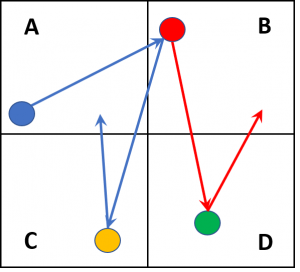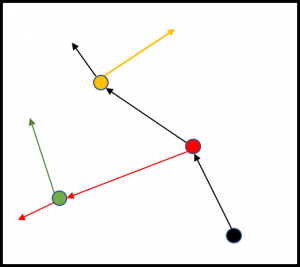How does a virus (e.g., Coronavirus) spread in a population composed of several classes of individuals that have distinct interactions? Eigenvalues are an effective tool to understand the rate of exponential growth in the initial stages. (View pdf)
Lake Covering Problem and a Solution to the Particles Riddle
Lake Covering Problem
A circular lake of radius meters must be covered by rectangular boards of length
meters. Rectangular boards of all widths are available, but the cost of a covering is the total width of the boards used. Clearly the lake can be covered by using parallel boards of total width
meters. Is there a more efficient covering possible? Here are examples of two competing coverings.

Solution to Particles Riddle
In a previous post I discussed the Particles riddle, a solution of which is as follows. Cover the unit square by four closed subsquares of side length 1/2, denoted as in the figure. Suppose that the initially awake particle is located at
, and there are sleeping particles in
(the case when some of these are unoccupied is easy to handle.) The particle at
wakes up a particle at some point
by time
. During the next
time units, one of these two particles can travel to wake a particle in some
in
, and at the same time, the other can travel to wake a particle at some
in
. In another
time unit, one of the particles from
can travel to
and one of the particles at
can travel to
. Thus by time
, there will be an awake particle in each of the originally occupied subsquares
. The argument can now be iterated in each of these subsquares. Repeated subdivision will yield a geometric series
as an upper bound for the time needed to reach all
particles. The constant 6.2 can certainly be improved; we will not try to optimize this constant. See also a similar solution posted by Sang-il Oum here.

The argument above readily generalizes to higher dimensional cubes (where the constant will depend on dimension) and to other self-similar sets. Compactness and convexity are not enough, however: Let be an orthonormal sequence in Hilbert space. Then the closed convex hull of
is compact, but the time needed to reach the first
vertices
is of order
.
A metric space is called a
if the distance between any two points equals the length of the shortest curve between them (In this case one also says that
is an instrinsic metric on
). In particular, a convex set in a Banach space is a length space; for the particle problem, it is natural to restrict attention to length spaces. The assumption that the particles travel at most at unit speed means that their paths are Lipschitz maps from
to
with Lipschitz constant
.
A large class of length spaces where any finite collection of points can be reached in bounded time are length spaces. A metric space
is called
if there is some doubling constant
such that every ball
in
of any radius
, can be covered by at most
balls of radius
. See https://en.wikipedia.org/wiki/Doubling_space.
The following statement is easily proved by induction on : Given
particles, one of them awake, in a doubling length space with doubling constant
and diameter
, all particles can be woken up by time
. (As before, awake particles travel at unit speed).
Thanos and Particles Riddles
Here are two riddles, the solutions of which I will discuss next week. Interested readers are welcome to email me solutions.
Thanos Problem
Thanos, the all-powerful supervillain, can snap his fingers and destroy half of all the beings in the universe.
Suppose now there are Thanoses, each snapping his fingers in a sequence, one after the other. When a Thanos snaps his finger, each being (Thanos or human) dies independently with probability
.
Question: Out of people on Earth, how many can we expect to still be alive at the end? More formally, let
be the probability that a human being survives. Initial values:
,
.
Show that
, that is,
is bounded between positive constants.
Does
converge? If so, to what limit?
Does
converge? If so, to what limit?

Note: this problem was posted (with fewer details) by Oliver Roederon on the 538 blog, but without an analytical solution. The plot is due to Laurent Lessard (github).
Particles Problem
Suppose there are particles in the unit square. Initially one particle is awake and all others are sleeping. Each awake particle moves in the unit square at speed
in a direction you prescribe and wakes up any sleeping particle it encounters. The particles that are awake move simultaneously and particles can change direction at any point in time.
Question: Show that you can wake up all the particles by time . Note: I learned this problem from Maria Gringlaz.

New: A solution to the particles problem is now available here.